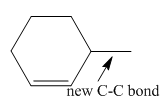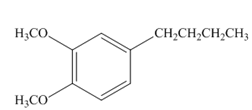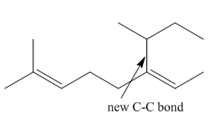
Concept explainers
(a)
Interpretation: Product of the given coupling reaction is to be predicted.
Concept introduction: Organocuprate reagents
Answer to Problem 26.1P
The product of the given coupling reaction is octane as shown below.

Explanation of Solution
Species containing copper-carbon bonds are known as organocuprate reagents. These reagents act as nucleophille and react with organic halides to form coupling products that contains new

Figure 1
Product formed from the coupling reaction is shown in Figure 1.
(b)
Interpretation: Product of the coupling reaction is to be predicted.
Concept introduction: Organocuprate reagents
Only one alkyl groupof the organocuprate reagent is transferred to form the product, while the other becomes part of reaction’s by-product.
Answer to Problem 26.1P
The product of the coupling reaction is

Explanation of Solution
Species containing copper-carbon bonds are known as organocuprate reagents. These reagents act as nucleophille and react with organic halides to form coupling products that contains new

Figure 2
Product formed from the coupling reaction is shown in Figure 2.
(c)
Interpretation: Product of the coupling reaction is to be predicted.
Concept introduction: Organocuprate reagents
Only one alkyl groupof the organocuprate reagent is transferred to form the product, while the other becomes part of reaction’s by-product.
Answer to Problem 26.1P
The product of the coupling reaction is

Explanation of Solution
Species containing copper-carbon bonds are known as organocuprate reagents. These reagents acting as nucleophille and react with organic halides to form coupling products that contains new

Figure 3
Product formed from the coupling reaction is shown in Figure 3.
(d)
Interpretation: Product of the coupling reaction is to be predicted.
Concept introduction: Organocuprate reagents
Only one alkyl groupof the organocuprate reagent is transferred to form the product, while the other becomes part of reaction’s by-product.
Answer to Problem 26.1P
The product of the coupling reaction is

Explanation of Solution
Species containing copper-carbon bonds are known as organocuprate reagents. These reagents act as nucleophille and react with organic halides to form coupling products that contains new

Figure 4
Product formed from the coupling reaction is shown in Figure 4.
Want to see more full solutions like this?
Chapter 26 Solutions
Organic Chemistry-Package(Custom)
- 9 7 8 C 9 8 200 190 B 5 A -197.72 9 8 7 15 4 3 0: ང་ 200 190 180 147.52 134.98 170 160 150 140 130 120 110 100 90 90 OH 10 4 3 1 2 -143.04 140. 180 170 160 150 140 130 120 110 100 90 CI 3 5 1 2 141.89 140.07 200 190 180 170 160 150 140 130 120 110 100 ៖- 90 129. 126.25 80 70 60 -60 50 40 10 125.19 -129.21 80 70 3.0 20 20 -8 60 50 10 ppm -20 40 128.31 80 80 70 60 50 40 40 -70.27 3.0 20 10 ppm 00˚0-- 77.17 30 20 20 -45.36 10 ppm -0.00 26.48 22.32 ―30.10 ―-0.00arrow_forwardAssign all the carbonsarrow_forwardC 5 4 3 CI 2 the Righ B A 5 4 3 The Lich. OH 10 4 5 3 1 LOOP- -147.52 T 77.17 -45.36 200 190 180 170 160 150 140 130 120 110 100 90 80 70 60 50 40 30 20 10 ppm B -126.25 77.03 200 190 180 170 160 150 140 130 120 110 100 90 80 70 60 50 40 30 20 10 ppm 200 190 180 170 160 150 140 130 120 110 100 90 80 TO LL <-50.00 70 60 50 40 30 20 10 ppm 45.06 30.18 -26.45 22.36 --0.00 45.07 7.5 1.93 2.05 -30.24 -22.36 C A 7 8 5 ° 4 3 7.5 7.0 6.5 6.0 5.5 5.0 4.5 4.0 3.5 3.0 2.5 2.0 1.5 1.0 ppm 9 8 5 4 3 ཡི་ OH 10 2 7.5 7.0 6.5 6.0 5.5 5.0 4.5 4.0 3.5 3.0 2.5 2.0 1.5 5 4 3 2 that th 7 I 7.0 6.5 6.0 5.5 5.0 4.5 4.0 3.5 3.0 2.5 2.0 1.5 115 2.21 4.00 1.0 ppm 6.96 2.76 5.01 1.0 ppm 6.30 1.00arrow_forward
- Curved arrows were used to generate the significant resonance structure and labeled the most significant contribute. What are the errors in these resonance mechanisms. Draw out the correct resonance mechanisms with an brief explanation.arrow_forwardWhat are the: нсе * Moles of Hice while given: a) 10.0 ml 2.7M ? 6) 10.ome 12M ?arrow_forwardYou are asked to use curved arrows to generate the significant resonance structures for the following series of compounds and to label the most significant contributor. Identify the errors that would occur if you do not expand the Lewis structures or double-check the mechanisms. Also provide the correct answers.arrow_forward
- how to get limiting reactant and % yield based off this data Compound Mass 6) Volume(mL Ben zaphone-5008 ne Acetic Acid 1. Sam L 2-propanot 8.00 Benzopin- a col 030445 Benzopin a Colone 0.06743 Results Compound Melting Point (°c) Benzopin acol 172°c - 175.8 °c Benzoping to lone 1797-180.9arrow_forwardAssign ALL signals for the proton and carbon NMR spectra on the following pages.arrow_forward7.5 1.93 2.05 C B A 4 3 5 The Joh. 9 7 8 1 2 7.5 7.0 6.5 6.0 5.5 5.0 4.5 4.0 3.5 3.0 2.5 2.0 1.5 1.0 ppm 9 7 8 0.86 OH 10 4 3 5 1 2 7.5 7.0 6.5 6.0 5.5 5.0 4.5 4.0 3.5 3.0 2.5 2.0 1.5 1.0 ppm 9 7 8 CI 4 3 5 1 2 7.0 6.5 6.0 5.5 5.0 4.5 4.0 3.5 3.0 2.5 2.0 2.21 4.00 1.5 2.00 2.07 1.0 ppm 2.76arrow_forward
 Organic Chemistry: A Guided InquiryChemistryISBN:9780618974122Author:Andrei StraumanisPublisher:Cengage Learning
Organic Chemistry: A Guided InquiryChemistryISBN:9780618974122Author:Andrei StraumanisPublisher:Cengage Learning
